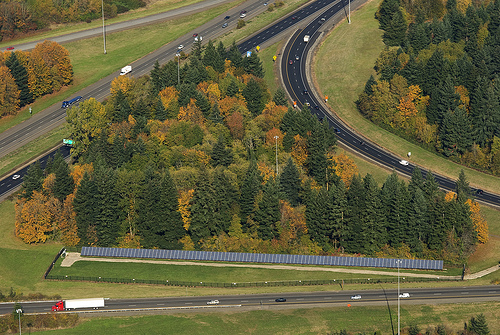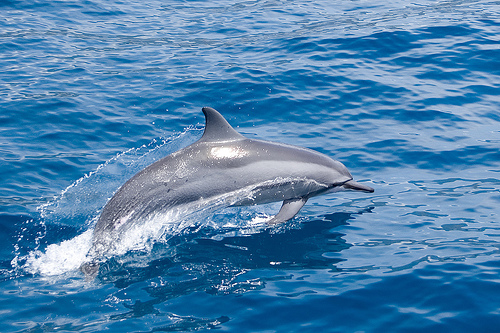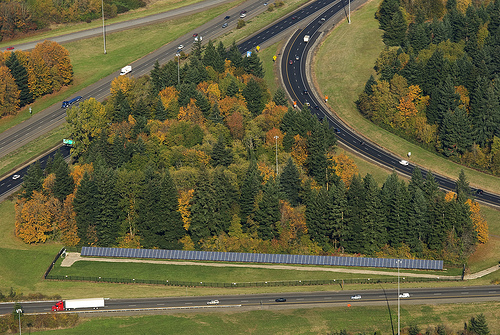 Oregon’s solar highway. Photo: Oregon Department of TransportationA recent column in the New York Times suggested that land use is the greatest environmental problem facing new renewable energy. While getting the facts terribly wrong, it opens a door to talk about the advantages of distributed generation rather than large, central-station power generation. A prime example is a unique proposal by Republic Solar Highways to put solar PV on highway right-of-way in California.
Oregon’s solar highway. Photo: Oregon Department of TransportationA recent column in the New York Times suggested that land use is the greatest environmental problem facing new renewable energy. While getting the facts terribly wrong, it opens a door to talk about the advantages of distributed generation rather than large, central-station power generation. A prime example is a unique proposal by Republic Solar Highways to put solar PV on highway right-of-way in California.
Robert Bryce’s column (the Gas is Greener) suggests that wind and solar have a large land footprint compared to gas and nuclear power, and therefore the latter are wiser environmental choices. Of course, Bryce hasn’t read about the Germans, who have installed 10,000 megawatts of solar PV in the past two years, over 80 percent on rooftops. Bryce’s concern for California meeting its 33 percent renewable energy standard by 2020 (the land use!) crumbles under the German’s torrid pace of rooftop solar development. If Californians could replicate the German solar PV program, the state could meet its renewable energy standard five years early without using a single acre of undeveloped land.
Bryce deserves a raspberry for his witless comment about wind farms, as well. Before claiming that wind uses 128 acres per megawatt, he may have wanted to look at an actual wind power project. Over 99 percent of a wind farm is simply the gaps between turbines to prevent interference (“wake turbulence”). In fact, 80 percent of U.S. wind farms use less than an acre per megawatt, one reason that many farmers and ranchers are delighted to host revenue-generating turbines on their property.
Despite its factual foibles, Bryce’s column underscores a fundamental problem with the renewable energy movement: the assumption that wind power can only be developed massive prairie wind farms and solar power can only be developed on hundreds of acres of virgin desert, and strung with high-voltage transmission lines.
The Germans put the lie to this assumption with their solar program and wind power development. And innovations in the U.S. also provide compelling counterexamples. Republic Solar Highways, for example, has proposed a 15 megawatt solar PV project along the right-of-way on U.S. Highway 101 in California. The plan would provide power for 3,000 homes and use land that currently gets an occasional mowing from the Department of Transportation, but is otherwise unused. The idea has a lot of merit, as we explored in our 2010 report Energy Self-Reliant States:
On either side of 4 million miles of roads, the U.S. has approximately 60 million acres (90,000 square miles) of right of way. If 10 percent the right of way could be used, over 2 million MW of roadside solar PV could provide close to 100 percent of the electricity consumption in the country. In California, solar PV on a quarter of the 230,000 acres of right of way could supply 27% of state consumption.
Moreover, there’s abundant evidence that developing solar and wind in this distributed fashion is more cost effective than building large, remote power plants. And you often don’t have to wait for new transmission lines to be planned, financed, rabidly opposed, and built despite significant opposition.
There are environmental drawbacks to some centralized solar and wind projects and their attendant new transmission lines, but Bryce vastly overstates their land use requirements, and glosses over the additional land natural gas and nuclear grind up for mining and extraction. More importantly, cost-effective distributed wind and solar power can be built in large numbers (but small sizes) without using undeveloped land, making mock of the idea that fossil fuels are more environmentally friendly in any fashion.
This post originally appeared on Energy Self-Reliant States, a resource of the Institute for Local Self-Reliance’s New Rules Project.
P.S. And to Bryce’s favorable comments on nuclear, distributed wind and solar don’t melt down, either.




